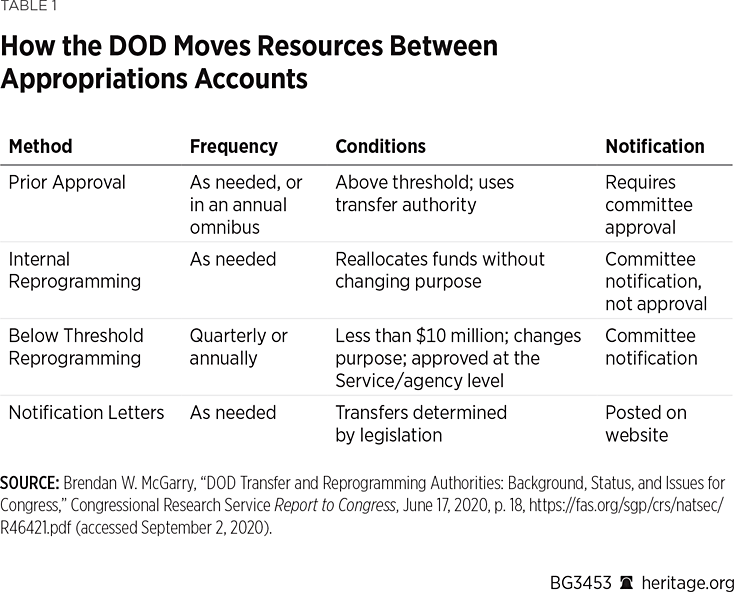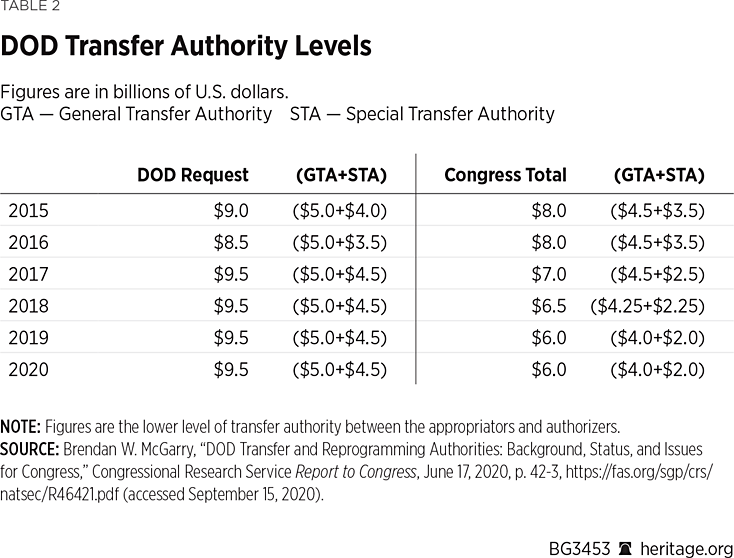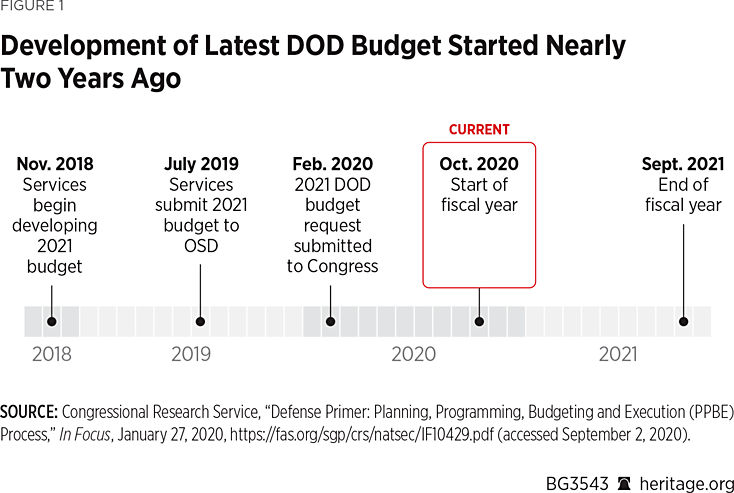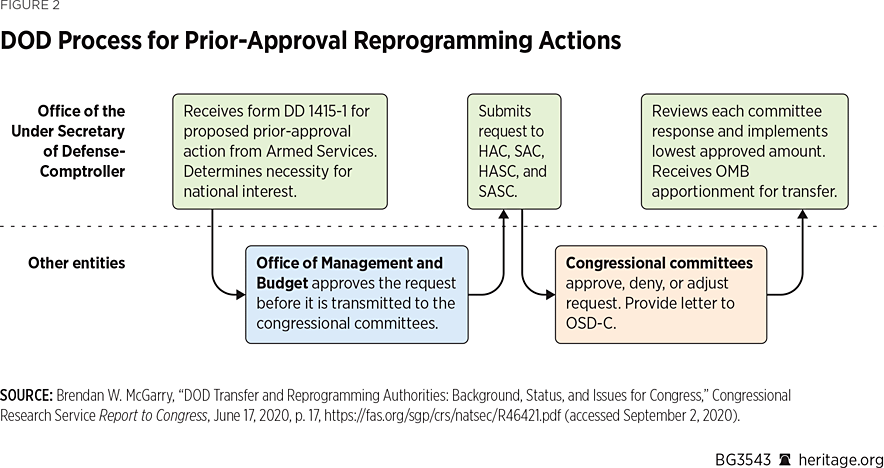During the Reagan Administration, the General Accounting Office, now named the Government Accountability Office (GAO), released a study on the Department of Defense’s (DOD’s) process for reprogramming funds.REF For a 34-year-old report, it is eerily current.
Reprogramming is how the executive branch modifies congressionally appropriated funds to respond to changes that take place during the period of execution—commonly known as the “year of execution.” In the past four fiscal years, the DOD reprogrammed between $3 billion and $5.2 billion using general and special transfer authorities each year in response to changing requirements and conditions.REF The process of reprogramming has remained the same for decades.
As the GAO reported in 1986, “Reprogramming is a cumbersome process within both DOD and the Congress because of the many levels of review and the wide variety of congressional committee review procedures.”REF It further explains that “reprogramming is necessary given the long lead times involved in preparing the annual budget and the size and complexity of the Defense budget.”REF
The normally arcane process of reprogramming was brought to the public’s eye when the DOD transferred resources for the construction of barriers at the southern border starting in 2019 without customary congressional approvals.REF As a response to this action, the House Appropriations Committee in its 2021 defense appropriations bill slashed the level of DOD reprogramming allowed from $6 billion to $1.9 billion.REF Regardless of the disagreements between the executive and legislative branches, such a severe reduction in transfer authority if ultimately enacted into law would exponentially increase the management challenges at the Pentagon and create further inefficiencies. A closer look at the reprogramming process also serves to highlight the many shortcomings of the current process.
The cumbersomeness reported in 1986 is still a hallmark of DOD reprogramming requests. A recent congressionally mandated panel tasked with evaluating acquisition regulations estimated that approval takes four months to six months, from initial request to final decision.REF A recent study from the Naval Postgraduate School measured Navy requests at an average of 96.28 days.REF This long process takes place in the context of the annual defense budget cycle, which starts around two years before being enacted.REF Thus, no matter how accurate the President’s budget request was at the time it was developed, it is inevitable that by the year of execution, changes will be necessary.
The inflexibility and lack of speed in the reprogramming process is especially troublesome in the new environment of great-power competition outlined by the National Defense Strategy, which places a premium on “deliver[ing] performance at the speed of relevance.”REF In a world that is becoming increasingly harder to predict and changing at a faster pace, the Pentagon is constrained by an antiquated reprogramming process that limits its ability to deliver the cutting-edge capabilities needed to compete on the world stage.
What Are Transfers and Reprogramming?
The Constitution dictates that Congress alone has the power to set how taxpayers’ dollars are allocated: “No Money shall be drawn from the Treasury, but in Consequence of Appropriations made by Law.”REF Since Congress controls appropriations, if any executive department wants to modify any appropriations in the ongoing fiscal year, save for some exceptions, most notably those relating to a national emergency, it must first ask Congress for those resources to be transferred or reprogrammed. When it comes to transfers and reprogramming, “Congress” has been interpreted to mean the committees of jurisdiction—in the case of the DOD, the Appropriations and Armed Services committees.
The challenges of executing appropriated resources when faced with changing conditions emerged early in the country’s history. As put by Naval Postgraduate School Professor Philip Candreva, the “idea of reprogramming is as old as the nation. An 1809 act, for instance, gave the President the authority to transfer funds when Congress was not in session and such authorities have ebbed and flowed ever since.”REF
In this context, for example, if the Army wanted to move resources appropriated to pay salaries to instead buy munitions, it would have to ask Congress for permission. Further, depending on the amount of money and where it is moving, there are different rules that need to be followed. Congress even established different terms to connote whether the money being moved is staying within the same appropriation type. A transfer involves shifting funds from one appropriations account to another, while a reprogramming involves shifting funds within the same account. The DOD uses the term “reprogramming action” to describe both transactions.REF
The differences between transfer and reprogramming is more relevant in Congress because there is a legal limit enacted annually for transfer defined by the annual defense appropriations and authorizations bill named the general transfer authority (GTA). In fiscal year 2020, this legal limit was set at $4 billion.REF Reprogramming procedures have different rules and limitations. Internally, the DOD refers to transfers that count against the transfer authority limits as “prior approval reprogramming.” It is one of the four main ways that the department uses to move resources between appropriations accounts. The other three are internal reprogramming, below-threshold reprogramming, and notification letters. Their characteristics are detailed in Table 1.
There are two different monetary limits that are important for the reprogramming process: the transfer authority limits and threshold limits. The transfer authority limit is currently composed of two different limits: (1) the GTA, for general use, and (2) the special transfer authority (STA), which largely governs the Overseas Contingency Operations account, designed for expenditures on military operations abroad.
Threshold amounts, specific to the different types of appropriations, are also set annually by Congress. Their purpose is to determine the level of congressional involvement required in each reprogramming request. If the reprogramming request is below the threshold, DOD rules require only congressional notification; but if above, an approval. In 2020, in the military personnel accounts and in the operations and maintenance accounts, the threshold was set at $10 million. In the procurement accounts and in the research, development, testing and evaluation accounts, the threshold is $10 million or 20 percent of the total, whichever is less.REF These thresholds can change annually, and have in the past.REF

When it comes to the transfer authority levels, in 2020, the DOD requested $5 billion in general transfer authority and $4.5 billion in special transfer authority, totaling $9.5 billion. Congress subsequently granted $4 billion in GTA and $2 billion in STA.REF The transfer authority levels since 2015 are outlined in Table 2.

Transfer authorities are necessary for providing the Department of Defense with a level of flexibility to respond to changes in the environment, such as a national disaster destroying parts of a military installation, fluctuations in foreign currency leading to more available resources, or to capture opportunities that were not present when the budget was approved, such as being able to speed up the development of a portion of a weapons system. From the start to the end of the fiscal year, there will be a constant flow of both new opportunities and challenges that require the DOD to be able to re-allocate resources to maximize the taxpayers’ investment in the national defense. That is especially true when considering how the DOD develops its budgets.
The Inherent Time Problem in the Defense Budget
The defense budget is governed by the Planning, Programming, Budgeting and Execution (PPBE) process established in 1961.REF It dictates how the defense budget request that the DOD submits every year to Congress is developed and submitted. As outlined by the Congressional Research Service, this process has inherently lengthy time horizons. The budget normally submitted to Congress in the first week of February was started about two years before its submission’s date.REF This means that some of the assumptions and calculations that underpin the amount of money that Congress appropriates for a program at any given year were established two years prior, and are likely going to be executed at least three years after it was first planned. Figure 1 outlines that cycle.

The length of time between the start of budget planning and execution strains any organization’s predictive capabilities. The process effectively asks the individuals and organization writing the budget estimates to predict the level and areas of resources that are going to be needed years into the future. It is not hard to imagine that any estimate made two or three years ago will need to be adjusted as it is executed.
Most of the budget process internal to the executive branch is consumed by levels of review. In the current process, a budget request for the Navy must be approved by that Service’s intermediate headquarters, and then moves to the Office of the Secretary of Defense and the Office and Management and Budget (OMB) for their subsequent reviews. Since budget oversight equates to power, no organization is willing to forgo the review.
As research fellow at the Center for Government Contracting Eric Lofgren puts it, the “program budget’s reliance on prediction makes it fragile to fundamental uncertainties and changes of information.”REF The reprogramming process tries, in a small way, to tackle these fundamental uncertainties and changes of information.
The Approval Process for a Reprogramming
Requests to reprogram funds normally start with a military Service. After they are submitted, there are three principal actors involved in approving a reprogramming request: the DOD, the OMB, and congressional committees. Each of these actors has its own internal process on how to handle reprogramming requests.
Thus, a component first sends its reprogramming request to its Service’s financial management and comptroller’s office. Once that office has approved it, the Service’s comptroller’s office sends it over to the comptroller’s office in the Office of the Secretary of Defense. From there, the request goes to the OMB for approval. Once approved by the OMB, the DOD can then submit the request to Congress for scrutiny. One congressionally mandated panel found that for a typical reprogramming request at least 12 different offices were required to approve the request before it ever gets to Congress for actual approval:
- Program manager,
- Military Service comptroller appropriation manager,
- Military Service budget manager,
- Military Service budget director,
- Military Service comptroller,
- Military Service vice chief of staff,
- Military Service secretary,
- DOD Directorate for Freedom of Information and Security Review,
- DOD Comptroller budget directorates,
- DOD Comptroller,
- Deputy Secretary of Defense, and
- Office of Management and Budget.REF
Figure 2 describes the workflow on a higher level, from the initial submission form called DD 1415-1,REF to action on the request.

Once the request makes its tortured path to Congress from the OMB, the process begins when all four committees—the House and Senate Armed Services Committees, and the Defense Subcommittees of the House and Senate Appropriations Committees—receive the request. A typical prior approval reprogramming request must obtain the approval of the chairman of each of these committees. The official prior approval reprogramming request contains the basic facts providing the justification of the proposed increase and the decreases. Each action is justified by a short paragraph of text.REF Thus, in most cases, the congressional staff responsible for evaluating the reprogramming must also request a briefing from the DOD on the proposal. The evaluation process takes place largely in parallel with the majority and minority staff in the four committees.
Philip Candreva points out that “[e]ighty-five percent of the time, Congress did not alter the request, but let it proceed as requested.”REF Another recent study puts the approval rate at 84 percent.REF For the other 15 percent or so, some are altered, some have the reductions denied, and a few are denied in full, both the increase and the reduction. Of those that have some alteration, the DOD implements the most restrictive version, if there is disagreement among the different committees.REF
This entire process has been found to take between four months and six months.REF Each of the 12 different stakeholders inside the executive branch and the four different committees in Congress can substantially slow down the process, and each of them could fail to act or delay its action and stop the process in its tracks.
Recommendations for a Better Reprogramming Process
Reprogramming sits in the intersection between congressional power over appropriations and the necessary flexibility to adapt budget plans to new realities. As put by constitutional scholar Louis Fisher, the “conflicting needs of administrative flexibility and congressional control are often reconciled by what has come to be known as ‘reprogramming.’”REF The state of reprogramming and transfers are a reflection of the trust and partnership that has developed or eroded. Fischer captures this ebb and flow when discussing the early development of reprogramming actions:
Congressional control over defense reprogramming has progressed through a number of stages. At first the Appropriations Committees required the Defense Department to keep them advised of major reprogrammings; later the Department had to submit semiannual reports; finally the Pentagon was required to obtain prior approval from the Appropriations Committees before implementing certain kinds of reprogramming actions.REF
The balance between congressional oversight and executive flexibility comes with the sense that Congress “recognize[s] that the budget is merely a plan and the plan is over a year old by the time the funds are executed. Some flexibility is required to meet the nation’s needs.”REF When taking into account the need for some level of flexibility combined with the increased agility required in the scenario of great-power competition outlined by the National Defense Strategy,REF Congress and the executive branch should revisit the rules for reprogramming.
Any changes in how reprogramming and transfers work will require the executive and legislative branches to work closely together to establish a system built on mutual trust. As such, the executive and legislative branches should:
- Establish a fast-track for low-risk reprogramming requests. As pointed out by Lieutenant Chad Roum: “Overall, about 85 percent of all prior approval reprogramming requests went unchanged. In general, this shows the defense committees defer to the Defense Department’s judgment.”REF This indicates that most of requests that reach Congress are justifiable and well-formulated. Further, some are based on the facts of life of running a program. Candreva explains that “‘Fact of life’ changes are presented by program offices, operational units and support organizations. These include contingent events like unexpected maintenance requirements, special provisions of law, a contractor breach, operational tempo changes, fuel price changes, and unfavorable test results.”REF
- Congress and the DOD should define the common characteristics among the requests that are approved without any modifications, and highlight those characteristics in any request. There could be a scale of points to determine the political risk of each reprogramming request. This would help Congress to process reprogramming requests faster, and further develop a common language between the two branches of government. There needs to be a more nuanced approach to how both the executive and Congress treat reprogramming requests, which will be derived by understanding the shared characteristics of requests with high approval rates.
The Department of Defense should:
- Provide more detailed justifications and move beyond static data. The reprogramming requests usually arrive in Congress with the same level of detail as the publicly available forms on reprogramming requests. The DOD should work with Congress to develop a platform that allows congressional staffers to access more detailed and updated data from reprogramming requests. Right now, the Pentagon sends forward static scanned-in copies of forms. Even if the platform and the data are not accessible to the public, they will both help to build confidence in the process and in the data. The platform could also be used to track the status of the reprogramming, from initial request to the multiple layers of approval.
- Accelerate the process in the executive branch. The lengthiest part of the process is the time involved from getting the request from the program manager until it gets in the hands of the congressional staffer. The multiple layers of approvals and evaluation undoubtedly contribute to the high approval rate that reprogramming currently enjoys. However, there is room to downgrade some of the required approvals into notifications, especially if the reprogramming request is a candidate for the fast track.
Congress should:
- Raise the transfer authority level proposed by the House in the 2021 defense appropriations bill. In its 2021 defense appropriations bill, the House proposed cutting transfer authority to $1.9 billion.REF Based on history, that amount is clearly insufficient and will have deleterious impacts on the national defense.
- Test different reprogramming thresholds. The thresholds for reprogramming and levels of general transfer authority have not changed substantially in a long time. Congress should grant more flexibility in different areas in order to see how the financial management community at the DOD reacts and uses those authorities. In recent years, GTA peaked at 1.6 percent of the budget in 2016, and has consistently declined afterwards, currently standing at under 1 percent.REF Congress should raise it to 2 percent of the budget, which would be around $14 billion per year, for two consecutive fiscal years and evaluate the results.
Conclusion
Reprogramming requests sit between necessary congressional oversight and its power of the purse, and the realities of executing a budget built on years-old estimates. There is an inherent need to reprogram resources, be it to allow a base to rebuild after a natural disaster, to move personnel resources after a slow recruiting year, or to accelerate a technology that is proving successful. Since a successful reprogramming process depends on the trust built between Congress and the Department of Defense, both parties should take the opportunity to build further trust and streamline the system. After all, to be effective, national defense must be a team sport that requires close collaboration and cooperation between the branches of the federal government.
Frederico Bartels is Senior Policy Analyst for Defense Budgeting in the Center for National Defense, of the Kathryn and Shelby Cullom Davis Institute for National Security and Foreign Policy, at The Heritage Foundation.


